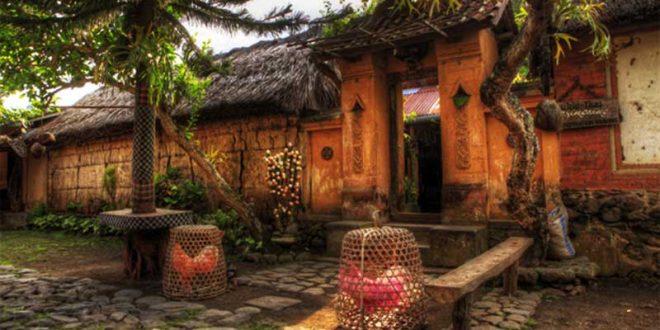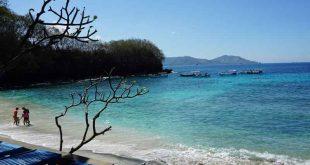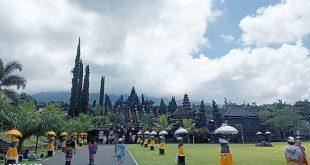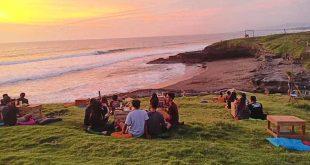Tenganan Bali Age Village Located on the northwest side of Candidasa, about 4 km from the main road. The Tenganan is a symmetrical Bali Aga village with walled houses and unique handicrafts. Tenganan Village or Tenganan Pegringsingan is one of the ancient villages on the island of Bali.
This village reflects the cultural life of its people and the customs of Bali Aga Village (pre-Hindu) which are different from other villages in Bali. Therefore, Tenganan Village was developed as a popular cultural tourism object.
History of Age Tenganan Village, Bali
The village area consists of three complexes, namely housing complexes, plantations and rice fields. The history of Tenganan village is expressed in several versions.
- The first version states that the residents of Tenganan Village come from Paneges Village, a village located near Bedahulu Village which is located in Gianyar Regency.
- The second version reveals the word Tenganan which is known in one of the Balinese inscriptions which is written with the word Tranganan.
- The third version, residents of Tenganan Village pray at Bukit Lempuyang Temple.
The meaning of Tenganan
The word Tenganan comes from the root word Tengah which can mean towards the middle of Pegringsingan, a type of woven cloth that is typically produced by the people of Tenganan village.
The population structure in Tenganan village is built linearly consisting of six rays. Each ray consists of several broad courtyards, in the form of buildings that are used by the local community to present their handicrafts to tourists.
All existing human traditions are in harmony with God, humans and the environment in accordance with the concept of Tri Hita Karana. Tenganan Tourism Destinations are still attractive, both as cultural tourism, natural tourism and agricultural tourism.
Attraction of Age Tenganan Village, Bali

The houses in Tenganan Pegringsingan village are built on both sides from north to south of the concourse with open doors above. The house’s entrance is narrow, only allowing one person in or out at a time.
One entered the village through the gate at the south end. On either side of the entrance there are two small temples. Opposite is the long bale agung, where administrative decisions are made for the village.
Next to it is a drum tower (kul-kul). Kul-kul is hit 21 times every morning to start the day. In the nave are a series of communal pavilions (balé) for ceremonial gatherings.
Here we can see how the Balinese actually carry out their daily lives through the traditions they so adhere to, untouched by outside cultural influences.
The traditional row houses still look very well maintained, as is the village’s main town hall. A remote village surrounded by hills makes the air cool and pollution-free.
The friendliness of the people makes tourists more comfortable and can get to know Tenganan more deeply. On the side of the main road many local people (mainly men) make and sell palm calendars related to Tenganan.
The Tenganan calendar is made of palm leaves. Each palm leaf is arranged vertically and connected by a rope. At the top and bottom there are bamboo slats to strengthen the calendar. When folded, it looks like a bamboo stick but has a calendar inside.
Traditional Mekaré-kare ( Tenganan Bali Age Village )

Another highlight of Tenganan is the traditional Mekaré-kare ritual, also known as the Pandan War. Mekaré-kare is the culmination of a series of ceremonies held at Ngusaba Sambah every June and lasts for 30 days.
During one month, Mekaré-kare is carried out 2-4 times and each time a gift is given to the village’s ancestors. Men are involved in Mekaré-kare from childhood to old age.
As the name implies, he uses pandan leaves which are cut into pieces of about 30 cm, which can be used as weapons and shields to fend off opponents from scratches by pandan thorns.
Wounds caused by scratching will be covered with pandanus which is made from plants and tubers such as galangal, turmeric and others.
Mekaré-kare is essentially the same as the Tabuh Rah ceremony performed by Hindus in Bali when holding religious ceremonies. The Mekaré-kare ceremony is always accompanied by Selonding gamelan.
Another big attraction that is unique from Tenganan, which is not done anywhere else in Indonesia is the manufacture of double woven cloth. The word “Gringsing” comes from the word “Gering” which means illness or accident, and “sing” which means not, so the whole word “gringsing” means rejecting danger.
Gringsing fabrics are made in homes that also sell Gringsing fabrics. Tourists will enter the house freely even without a polite “excuse me” or “hello”.
Map Location of Tenganan Village – Map Location







